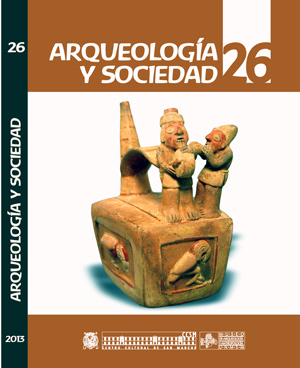HUACA DEL SOL STUDY FROM THE GENERAL SYSTEMS THEORY OF NIKLAS LUHMANN
DOI:
https://doi.org/10.15381/arqueolsoc.2013n26.e12393Keywords:
Huaca del Sol, The General systems Theory, design and architectural sequence, chronology, irritation.Abstract
After several investigations in Huaca del Sol (Uhle 1915; Hastings and Moseley 1975, Moseley 1975; Pozorski 1979 Narro Gallardo and 1992, Herrera and Ramirez 1992; Herrera and Chauchat 2003), the archaeological project Huacas de Moche (Moche Temples) initiated a research program that began in 2011. In this article, we present the excavations results in section 2 of Huaca del Sol from the systemic approach by Niklas Luhmann, which helped us to conceptualize and define our procedure to the particular demarcated issues. The conclusions, we present, show in first place, a long building autopoietic process, which has defined a three-phase construction sequence (last, penultimate and antepenultimate. The penultimate phase consists of two sub phases, which would indicate a complex building functionality associated at the beginning to domestic-residential activities and then to palace activities; in second place, it was suggested that the Moche collapse would have occurred after a crisis at the operational level where abstract and symbolic communication problems appeared.Downloads
Published
Issue
Section
License
Copyright (c) 2013 Henry Chávarri, Moises Tufinio, Patricia Gamboa

This work is licensed under a Creative Commons Attribution-NonCommercial-ShareAlike 4.0 International License.
THE AUTHORS RETAIN THEIR RIGHTS:
a. The authors retain their trademark and patent rights, and also on any process or procedure described in the article.
b. The authors retain the right to share, copy, distribute, perform and publicly communicate the article published in the Arqueología y Sociedad (for example, place it in an institutional repository or publish it in a book), with an acknowledgment of its initial publication in the Arqueología y Sociedad.
c. The authors retain the right to make a subsequent publication of their work, to use the article or any part of it (for example: a compilation of their works, notes for conferences, thesis, or for a book), provided that they indicate the source. of publication (authors of the work, journal, volume, number and date).






